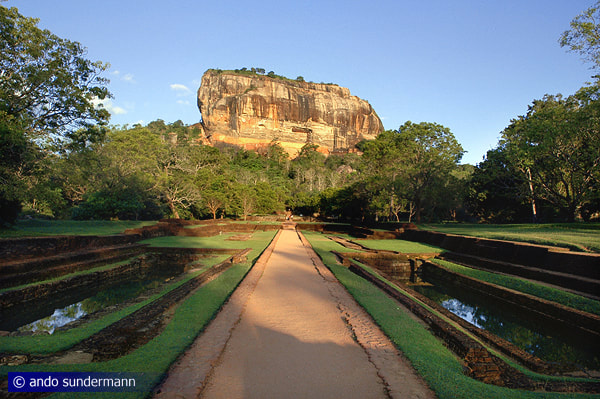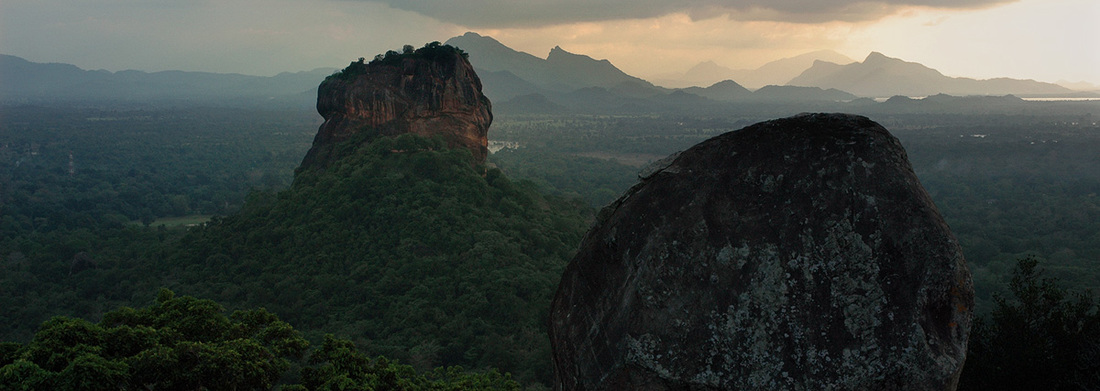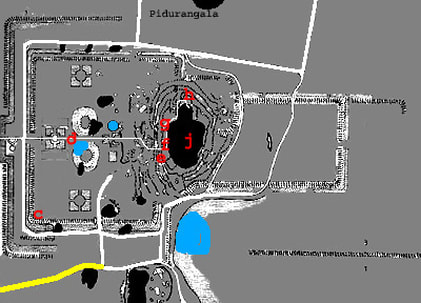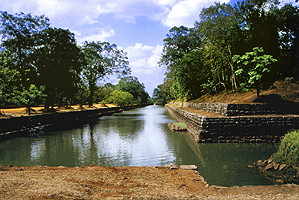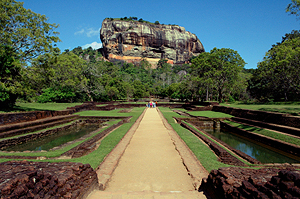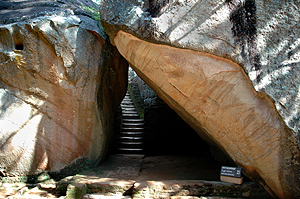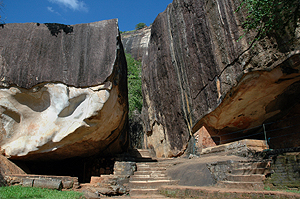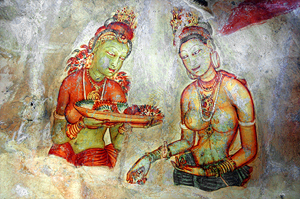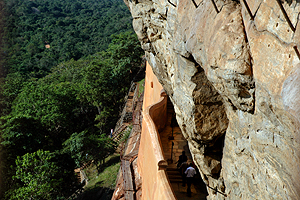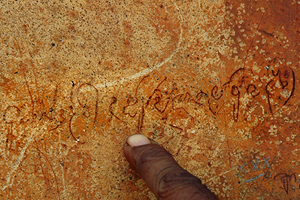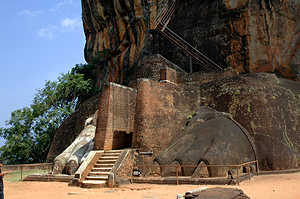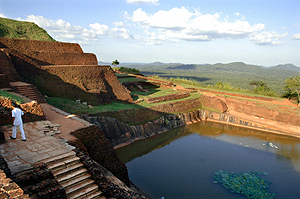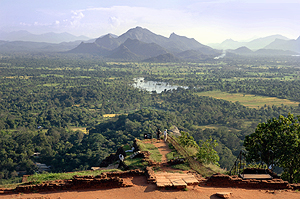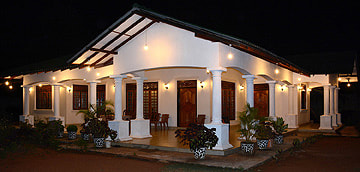Sigiriya, Sri Lanka’s must-see heritage attraction, is one of the most exciting and inspiring ancient places in Asia, combining natural beauty and historical significance. Astonishing every visitor with its outstanding works of art and engineering achievements and magnificent views, Sigiriya likes to be called “eigth wonder of the world”. A tragic history of patricidal coup d’etat and fratricidal war suits Sigiriya’s dramatic setting. It was a new kind of sacred site and royal palace and fortress and entire capital city built in 5th century C.E. by King Kassapa, after he left Anuradhapura in fear of revenge of his half-brother Moggallana, the rightful heir to the throne, for occupying the throne after killing their father, the meritourious King Dhatusena. In less than two decades a new city of unique layout and symbolism was created to safeguard and legitimize the reign of the new king. Many surprisingly unparalleled features of this UNESCO World Heritage Site are thrilling visitors from Sri Lanka and all over the world: the symmetry of the landscape garden with ancient fountains still in function, the extraordinary grace of representations of women in the murals called “Sigiriya frescoes”, the first known examples of Sinhalese poetry engraved in walls, the remnants of a lion sculpture that once was Sri Lanka’s largest statue at all, last not least the spectacular location of the ruins on the summit of the isolated rock.
 Sigiriya Water Gardens in Char Bagh order
Sigiriya Water Gardens in Char Bagh order
Visiting Sigiriya takes at least three or four hours. Starting point is the western gate of the citadel. Crossing the moat of this best-preserved ancient fortress of the island, which is a perfect rectangle of 800 metres width and 1200 metres length, you should be aware, that you are entering only the royal core of the city that onyce stretched far into western direction. This overgrown settlement area outside the “city walls” was the founding place of more foreign coins than any other place in the Cultural Triangle, indicating the importance of Sigiriya as an international trade centre in antiquity. Entering the citadel, with the landmark view to the steep Sigiriya rock, you are entering the so-called water garden with an axial passage and symmetrical arranged bassins similar to much earlier Persian and much later Moghul garden architecture but unprecedented in South Asia those days. There are artificial fountains that can still be seen during the local wet season.
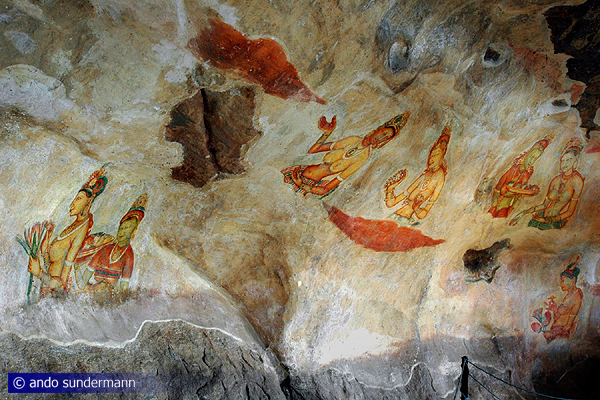 Fresco Pocket "Deraniyagala Cave" at the Sigiriya Rock
Fresco Pocket "Deraniyagala Cave" at the Sigiriya Rock
At the foot of the Sigirya Lion Rock is a labyrinthic so-called boulder garden, a natural landscape garden contemporary to early examples of Chinese lanscape gardens. This part of the royal pleasure garden is dotted with rock shelter in which remnants of an even earlier history can be seen: Before becoming the capital of King Kassapa, Sigiriya had aready served as the abode of Buddhist monks. Climbing the ancient stairways, you will reach a second ticket checkpoint at the foot of two modern circular staircases, which are enabling you to reach the rock shelter high above ground level, where some of the original “Sigirya frescoes” from the fifth century survived, the so called “cloud maidens”. The fascinating beauty of these paintings inspired visitors already more than 1000 years ago to praise them in small poems spontanuously inscribed on the plaster of an ancient wall protecting the aisle running along the rock in about 80 metres above ground level and 80 metres below the top level. These earliest examples of writings in Sinhala are called “Sigiriya graffity” and the brightly plastered wall, which was once polished and reflecting the light, is known as the “Mirror wall”. It ends at the foot of the lion paws, which belong to a once colossal lion sculpture made of brick that covered the entire northern end of the Sigiriya monadnock, which is therefore called the “Lion Rock”. Walking through the Lion paws you reach the final part of the ascent to to top, knowadays secured by iron railings. The very top of the Sigiriya Lion Rock is covered with foundations of brick monuments on different levels. The ancient structure, presumably the palace of King Kassapa, appears like a ship high above the surrounding plains, offering you a perfect 360-degree panoramic view to the area now called “Sri Lanka’s Cultural Trinagle”, which was once the heartland of the ancient Sinhalese civilization.
|
Sigiriya in Matale District of the Central Province, is situated right in the centre of Sri Lanka's Cultural Triangle, 18 km northeast of Dambulla and 11 km south of Habarana. Minneriya and Kaudulla National Parks are within day-trip distance.
|
Excursus: Sigiriya rock is NOT a remnant of a volcano
Several internet articles claim that Sigiriya rock is the magmatic core of a former volcano. But this seems to be the result of confusing every kind of "igneous rock" with "volcanic origin". Sigiriya is a granite rock and granite is indeed an igneous rock that forms from magma solidifying underground. However, not all granite formations are associated with volcanic activity. Some granite formations result from the cooling and solidification of magma deep within the Earth's crust, without any direct volcanic activity involved. In the case of Sigiriya, the rock itself is a granite formation that formed from magma cooling underground. While granite is commonly associated with volcanic regions, it can also form in non-volcanic settings through processes like intrusive igneous activity, where magma solidifies below the Earth's surface. Therefore, while the rock at Sigiriya is of igneous origin, it's not directly tied to volcanic activity in the area.
History of Sigiriya
Sigiriya is one of the most elaborate surviving ancient urban sites in South Asia, systematically planned and worked out on a huge scale. All the more surprising is: Historians came to no undisputable conclusions about the reason for founding it nor its abandonement nor its religious symbolism. Sigiriya indeed remains to by a mystery.
It’s likely but not proven, that the rock shelters at Sigiriya Rock, like those of the neighbouring Pidurangala Rock and Aligala cave, were inhabited already in prehistoric times, 5000 years ago. Archaeological findings have revealed that Buddhist monks occupied the rock shelters at Sigiriya already in the earliest period of Buddhism in Sri Lanka, starting in the 3rd century BC. Some rock inscriptions, which can be dates as far back as to this early Buddhist period, state that the caves were donated to the Buddhist Sangha.
The impressive fortress and palaxe and garden architecture, remnants of which are today’s World Heritage Site Sigiriya, are from fifth century C.E. They were built in the beginning of the rule of the Moriyan dynasty. The second part of the Mahavamsa Chronicle, sometimes called Culavamsa tells the story of the “Lion Rock” (Sihagiri) at the end of the 38th and begin of the 39th chapter. According to this record, stemming from much later centuries, Sigiriya would have been built and served as the capital during the reign of one single king, Kassapa I., for a period of only 18 years. However, historians doubt that this is a fully accurate account, because the Sigiriya story (see below) has obviously a very dramatic composition and is told like a teaching play about the bad effects of emotions like grudge and anger and lack of seld-control according to the law of Karma. It seems unlikely, that an entire city which lasted less than two decades could have left so many traces of a commercial hub. There is no other place in Sri Lanka, where more coins have been found than in Sigiriya. By far the most of them were of Roman or Indo-Roman origin. This does not necesarrily mean, they were payments of foreign traders. It seems more likely, that Sri Lanka simply used those international bronze coins as its own currency those days. Nevertheless, Sigiriya was obviously more than a fortress of a paranoic king, it was an urban settlement. Furthermore, there is little archaeological evidence, that the constructions on the summit of Sigiriya rock are any kind of palace. Likewise, it could have been sacred architecture, ignored by the chronicle because belonging to a Mahayanist or another kind of religious tradition that was considered heretic by the chroniclers. There are strong indications, that the entire “Lion Rock” was designed as a religious symbol representing the mountain abode of Lord Kuvera. However, this does not contradict the traditional theory that Sigiriya was a royal palace, because in this case the religious connotation could simply indicate that a ruler tried to be heightened to a godking status. Besides the chronicle’s report of Sigiriya-founder Kassapa killing his father and committing suicide in the battle against his brother, there are many versions of the Kassapa story told in folk legends. Alternative stories have King Dhatusena as the initial builder of Sigiriya, with Kassapa only finalizing the work in honour of his father. Other stories depict Kassapa as a playboy king using Sigiriya as his pleasure palace. Instead of suicide on the battlefield, the reason for his death is poisoning on order of a concubine.
There can be no doubt that Sigiriya was left completely and fell into decay already during the Anuradhapura period. It was reoccupied be reclusive Buddhist monks who then again lived in the rock shelters at the foot of the rock. The beauty of the abandoned Sigiriya rock itself nevertheless attracted visitors already in the late Anuradhapura period. The evidence for it is the “Sigiriya graffity” left by those early travellers, written in the 8th till 14th century.
In 1831, the British Major Jonathan Forbes climbed the summit of Sigiriya and rediscovered the impressive ruins, which then were completely overgrown. Archaeological research in Sigiriya began in the late 19th century. H.C.P. Bell, Archaeological Commisioner of British Ceylon, was the first scientist to conduct extensive research on Sigiriya. It was the last Archaeological Commisioner of British Ceylon and the first after independence, Senarath Paranavitana, the doyen of archeology and epigraphy in Sri Lanka, who contributed most to the research and interpretation of Sigiriya. In particular, he deciphered and published the poem called “Sigiriya graffiti”.
It’s likely but not proven, that the rock shelters at Sigiriya Rock, like those of the neighbouring Pidurangala Rock and Aligala cave, were inhabited already in prehistoric times, 5000 years ago. Archaeological findings have revealed that Buddhist monks occupied the rock shelters at Sigiriya already in the earliest period of Buddhism in Sri Lanka, starting in the 3rd century BC. Some rock inscriptions, which can be dates as far back as to this early Buddhist period, state that the caves were donated to the Buddhist Sangha.
The impressive fortress and palaxe and garden architecture, remnants of which are today’s World Heritage Site Sigiriya, are from fifth century C.E. They were built in the beginning of the rule of the Moriyan dynasty. The second part of the Mahavamsa Chronicle, sometimes called Culavamsa tells the story of the “Lion Rock” (Sihagiri) at the end of the 38th and begin of the 39th chapter. According to this record, stemming from much later centuries, Sigiriya would have been built and served as the capital during the reign of one single king, Kassapa I., for a period of only 18 years. However, historians doubt that this is a fully accurate account, because the Sigiriya story (see below) has obviously a very dramatic composition and is told like a teaching play about the bad effects of emotions like grudge and anger and lack of seld-control according to the law of Karma. It seems unlikely, that an entire city which lasted less than two decades could have left so many traces of a commercial hub. There is no other place in Sri Lanka, where more coins have been found than in Sigiriya. By far the most of them were of Roman or Indo-Roman origin. This does not necesarrily mean, they were payments of foreign traders. It seems more likely, that Sri Lanka simply used those international bronze coins as its own currency those days. Nevertheless, Sigiriya was obviously more than a fortress of a paranoic king, it was an urban settlement. Furthermore, there is little archaeological evidence, that the constructions on the summit of Sigiriya rock are any kind of palace. Likewise, it could have been sacred architecture, ignored by the chronicle because belonging to a Mahayanist or another kind of religious tradition that was considered heretic by the chroniclers. There are strong indications, that the entire “Lion Rock” was designed as a religious symbol representing the mountain abode of Lord Kuvera. However, this does not contradict the traditional theory that Sigiriya was a royal palace, because in this case the religious connotation could simply indicate that a ruler tried to be heightened to a godking status. Besides the chronicle’s report of Sigiriya-founder Kassapa killing his father and committing suicide in the battle against his brother, there are many versions of the Kassapa story told in folk legends. Alternative stories have King Dhatusena as the initial builder of Sigiriya, with Kassapa only finalizing the work in honour of his father. Other stories depict Kassapa as a playboy king using Sigiriya as his pleasure palace. Instead of suicide on the battlefield, the reason for his death is poisoning on order of a concubine.
There can be no doubt that Sigiriya was left completely and fell into decay already during the Anuradhapura period. It was reoccupied be reclusive Buddhist monks who then again lived in the rock shelters at the foot of the rock. The beauty of the abandoned Sigiriya rock itself nevertheless attracted visitors already in the late Anuradhapura period. The evidence for it is the “Sigiriya graffity” left by those early travellers, written in the 8th till 14th century.
In 1831, the British Major Jonathan Forbes climbed the summit of Sigiriya and rediscovered the impressive ruins, which then were completely overgrown. Archaeological research in Sigiriya began in the late 19th century. H.C.P. Bell, Archaeological Commisioner of British Ceylon, was the first scientist to conduct extensive research on Sigiriya. It was the last Archaeological Commisioner of British Ceylon and the first after independence, Senarath Paranavitana, the doyen of archeology and epigraphy in Sri Lanka, who contributed most to the research and interpretation of Sigiriya. In particular, he deciphered and published the poem called “Sigiriya graffiti”.
Story of Sigirya - the famous tragedy of King Kassapa
Prince Kassapa (the Sanskrit equivalent of this Pali name is "Kashyapa") was the elder of two brothers. But he was not the heir to the throne, because he was born to a concubine, whereas his younger brother, Moggallana, was the son of the royal consort. Kassapa harboured a jealousy towards his half-brother Moggallana.
Kassapa secretly conspired with Dathusena’s general, Migara, who was furious, because King Dhatusena had treated his daughter in cruel way. Migara whispered to Kassapa, that his father, the king, would be hiding a treasure and planning to give ir only to Mogallana. This enraged Kassapa, he carried out a palace coup, in 479 he overthrew Dhatusena and held him in captivity. When Kassapa sent messengers to his father to ask him where he was hiding his treasures, Dhatusena was answering at the Kalawewa, the huge tank that had been constructed by the old king for irrigation purposes. Dhatusena pointed to the lake he had created and said: "This is my entire treasure". Hearing this, Kassapa got furious and killed his father by wallling him up alive. Kassapa's brother Mogallana, fearing for his life, fled to India.
Like many other usurpers, Kassapa became a paranoid ruler. He lived in constant fear, his brother could return to the island and claim rightfully his throne. Because the Buddhist monks in Anuradhapura were hostile to the usurper and out of fear, Kassapa decided to shift his captal from Anuradhapura to a much a place further south, which was farer away from the shores of the island and easily to defend. That's the reason why Kassapa chose the steepest single rock of Sri Lanka as his new residence and fortified the entire rock. Sigiriya became the strongest fortification of ancient Sri Lanka. Astonishingly, the construction work for this new capital lasted only several years.
In 497, Mogallana returned from southern India with an army of Tamil mercenaries. When Moggallana advanced towards Sigiriya, Kassapa left his fortress atop his elephant and personally led his army against that of his brother. On the battlefield, Kassapa's elephant came to a muddy soil, the animal hesitated and backed up. But when his own troups saw Kassapa backtracking, they wrongly assumed that he was signalling retreat. Withdrawing from the battlefield, the army left behind Kassapa alone. Now finding himself surrounded by his enemies, the unfortunate Kassapa raised his own sword and brought it down into his belly. So the life of the patricidal king came to a tragic end and the short period of Sigiriya as Sri Lanka’s capital was over, too, because the new king, Mogallana, chose Anuradhapura as his residence again.
Kassapa secretly conspired with Dathusena’s general, Migara, who was furious, because King Dhatusena had treated his daughter in cruel way. Migara whispered to Kassapa, that his father, the king, would be hiding a treasure and planning to give ir only to Mogallana. This enraged Kassapa, he carried out a palace coup, in 479 he overthrew Dhatusena and held him in captivity. When Kassapa sent messengers to his father to ask him where he was hiding his treasures, Dhatusena was answering at the Kalawewa, the huge tank that had been constructed by the old king for irrigation purposes. Dhatusena pointed to the lake he had created and said: "This is my entire treasure". Hearing this, Kassapa got furious and killed his father by wallling him up alive. Kassapa's brother Mogallana, fearing for his life, fled to India.
Like many other usurpers, Kassapa became a paranoid ruler. He lived in constant fear, his brother could return to the island and claim rightfully his throne. Because the Buddhist monks in Anuradhapura were hostile to the usurper and out of fear, Kassapa decided to shift his captal from Anuradhapura to a much a place further south, which was farer away from the shores of the island and easily to defend. That's the reason why Kassapa chose the steepest single rock of Sri Lanka as his new residence and fortified the entire rock. Sigiriya became the strongest fortification of ancient Sri Lanka. Astonishingly, the construction work for this new capital lasted only several years.
In 497, Mogallana returned from southern India with an army of Tamil mercenaries. When Moggallana advanced towards Sigiriya, Kassapa left his fortress atop his elephant and personally led his army against that of his brother. On the battlefield, Kassapa's elephant came to a muddy soil, the animal hesitated and backed up. But when his own troups saw Kassapa backtracking, they wrongly assumed that he was signalling retreat. Withdrawing from the battlefield, the army left behind Kassapa alone. Now finding himself surrounded by his enemies, the unfortunate Kassapa raised his own sword and brought it down into his belly. So the life of the patricidal king came to a tragic end and the short period of Sigiriya as Sri Lanka’s capital was over, too, because the new king, Mogallana, chose Anuradhapura as his residence again.
Sigiriya Fortress - moats and ramparts
|
Sigiriya's fortifications are by far the strongest which were constructed by the ancient Sinhalese civilization. What can be seen at the western main gate today is still impressive, the moat is dead straight 800 long. Be aware, this was only the innermost of three rings of fortifications. The outermost earthen rampart was 43 m (141 ft) wide and over 6 km (4 miles) in length. The middle rampart was 37 m (121 ft) wide. An 8 m (26 ft) wide roadway ran along its top. The Sigiriya citadel was surrounded two moats. The outer moat, traces of which are still visible in the south-western corner, was 52 m (171 ft) wide and 4 m (13 ft) deep. The much better preserved inner moat is 23 m (75 ft) wide. There was another wall (4th fortication) surrounding the rock inside this inner citadell, but on a much smaller scale. Originally, the Sigiriya citadel had four entrances, the western gate was the ceremonial main entrance.
|
Sigiriya Water Gardens - ancient fountains still working
|
The water gardens cover the flat area between the wester gate and Sigiriya rock. The symmetrical layout and using water in this garden architecture on such a scale are unique in Sri Lanka. The Sigiriya water gardens, like the much later Mughal gardens of India, are inspired by ancient Persian water gardens. Three principal gardens are found in a row, to be crossed when proceeding to the Sigiriya Lion Rock. The first garden consists of a plot surrounded by 4 bassins in the very same arrangement as in a typical Persian "Char Bagh". Sigiriya's second water garden has deep pools on either side of the axial path. Two serpentine streams lead to the pools and fountains fed by underground water conduits are placed here. The 1600 years old fountains can still be seen functioning during the wet season. The third garden is smaller and situated on a higher level than the first two. It contains an octagonal pool with a raised podium on its northeast corner.
|
Sigiriya Boulder Gardens - early example of landscape garden
|
Sigiriya's boulder gardens at the foot of the Lion Rock consist of several large natural boulders linked by winding pathways. Sigiriya is a very early example of integrating rocks in garden architecture. Only China has older rock gardens, but of a different type, viz with artificial miniature mountains. The meditation pathes in Sigiriya's Boulder Garden are not the only indication that the natural setting was transformed into a pleasure garden indeed. Most of the boulders had a pavilion upon them, the cutted rock holes used as footings for wooden beams can still be seen. Also some foundation of brick walls on the boulder survived. It's not entirely sure, whether the Sigiriya Gardens were royal or monastic pleasure gardens. Ancient monasteries were embedded in gardens too, and some of them also had meditation pathes in a rocky surrounding.
|
Sigiriya Rock Shelters - Cobra Hood Cave and Cistern Rock
|
There are altogether 23 caves at the western foot of the huge Sigiriya Lion Rock. Actually, what is usually called "caves" in Sri Lanka, is more often called "rock shelter" or "abri" elsewhere. Like at many other rock formations on the island, the rock shelters of Sigiriya were used by reclusive monks as simple dwellings in the wilderness. Most Brahmi inscriptions in Sigiriya's caves are from the 2nd century B.C.E. till the 2nd century C.E., maybe the earliest are even from the 3rd century B.C.E.. Some of the rock sheltes show traces of paintings, for example the so-called Cobra Hood Cave, which is named after the natural rock hood surmounting it. Most of these paintings are from the period of Kassapa, but the geometrical paintings of the Cobra Hood Cave differ in style and could be even earlier. The Audience Hall Rock and the Cistern Rock are separated only by a narro chasm. A throne can be seen inside the Cistern rock and another one atop the Audience Hall Rock.
|
Deraniyagala Cave - Sigiriya's ancient art gallery
|
Almost unbelievable but true is, that once the entire western surface of the 185 m (607 ft) high Sigiriya Lion Rock has been a gigantic picture gallery. Pigments of murals have been found at least in an area of 40 m (130 ft) height and 140 m (460 ft) length. The Sigiriya graffities refer to 500 painted ladies. Only 22 of them survived, scilicet those sheltered by an overhang, hence not exposed to rainfall. This rock pocket about 100 m above ground level is named Dearniyagala Cave after a former Archaeological Commissioner of Sri Lanka, who did a lot of research here. An iron circular stair leads to this rock shelter high above the ground. Every visitor is amazed by the fresh coulours and the unimaginable beauty of the Sigiriya frescoes depicting elusive young ladies. They are known as Sigiriya's "cloud maidens" or "cloud damsels", because only their upper bodies can be seen, rising from red or grey clouds. They are not naked, but wear skin-tight blouses.
|
Sigiriya Frescoes - Cloud Maidens
|
The colours of the Sigiriya Frescoes are made of minerals, painted after three layers of plaster had been already dry. Actually, the correct Italian name for the painting technique would be "secco" and not "fresco". The painting style of the Sigiriya Cloud Maidens is consideres unique, though they are probably inspired by Central India's famous Ajanta paintings. The beauty of individual portraits even surpasses those known from Ajanta. All Sigiriya cloud maidens are gracefully bejewelled and depicted offering flowers. Most of them are grouped in pairs. The light-skinned ladies appear to be noblewomen, whereas the darker greenish ladies seem to be their servants, carrying plates with flowers which are then thrown downwards by the light-coloured ladies. There is an ongoing debate, whether the Sigiriya cloud maidens are portraits of court ladies or of celestial beings. Most probably they are Apsaras, delighting gods on the lower levels of the world mountain.
|
Sigiriya Mirror Wall - symbol of Himalaya snow
|
Just at the foot of the spiral staircase leading to the Sigiriya frescos, there is the starting point of a path leading to the Lion Paw Terrace. The railing of this ancient horizontal aisle along the western steep face of the Sigiriya Rock is called "Mirror Wall", because originally it was so highly polished that one could see a reflection of the own body on its smooth surface. Made of brick masonry, the Sigiriya Mirror Wall is covered with a plaster that originally was not only mirroring but of white colour. This white coulour of the Mirror wall could be seen from far distance, shimmering like a layer of snow on the dark surface of the granite Lion Rock. Indeed, this effect intentionally symbolized a mountain from the Himalayas, the cosmic mountain of the Gods. It seems likely, that King Kassapa intended his Lion Rock castle to be a representation of Mount Meru, indicating a new Hindu cult or even his own apotheosis, his royal palace being an artificial divine mountain.
|
Sigiriya Graffiti - oldest Sinhala poems
|
The Sigiriya Graffiti were inscibed in the Mirror Wall by ancient Sinhalese tourists, some are written in Tamil or in Sanskrit. The graffiti, deciphered by Sri Lanka's renowned historian Senarath Paranavitana, offer a fascinating insight into the cultural history of Sinhalese people and the evolution of their language. Many of these short poems praise the beauty of the "cloud maidens" and refer to them as ladies of the royal court. Some of the occasional verses bring to proof a high level of literacy and a deep appreciation of art. The majority of the writers had a higher education: noblemen, officials, and clergy. But some poets were common people, for example soldiers and craftsmen. Alphabetization in ancient Sri Lanka was higher than in Western civilizations. Notably, a dozen of the scribbler were women. In many other ancient cultures, women had no access to literacy.
|
Lion Paw Terrace - Sigiriya's giant Lion statue
|
Coming along the path of the mirror wall, the vistor arrives at the Lion Paw Terrace. This platform is midway at the northern face of the rock. There are remnants of to huge lion paws cut from the rock and of brick structures. This is what has survived from a Lion figure that once formed the entrance to the uppermost terrace. This sculpture made of brick was the largest statue ever built by the ancient Sinhalese civilization. It was the namegiving sculpture for the entire rock fortress of Sigiriya. The name mentioned in the Culavamsa part of the Mahavamsa is "Sihagiri", meaning "Lion Rock". Today's name "Sigiriya" is presumably derived from this ancient name, too. Through the Lion paw stairway, the summit can noe be reached taking a new iron stairway. It is highly recommended to keep calm here, because of aggressive wasps living at the Sigiriya monadnock. They are sometimes buzzing around the rock and attacking visitors.
|
Kassapa's Palace - Sigiriya Fortress in the Sky
|
Covering an area of around 1.6 hectares, the brick construction atop the island's most spectacular monadnock are the reason why Sigiriya is sometimes called "Machu Picchu of Sri Lanka" or "Eight Wonder of the World". Foundations can be seen on three levels of summit plateaus, all of them once covered with brick constructions. The structures are called "Kassapa's palace", though there are no traces of holes found at other ancient palace structures in Sri Lanka, serving as brackets for wooden beams. This is the main reason why some historians doubt, that the structures on the summit served as royal palace. Indeed, even if the pleasure gardens served as royal abode, the summit could have been a kind of temple. But in this case, too, the structures would be unique in Sri Lanka, differing significantly from all monastic architecture known from other ancient sites. As already mentioned. Sigiriya is shrouded in legends and remains to be a mystery
|
Panoramic view - from the Sigiriya Rock
|
There is a huge cistern atop Sigiriya rock and a wide pond, too. Strolling around, you will also find a huge monolithic chair called "Kassapa's throne" by tour guides. It might have been an Asana (seat) of a deity or a Buddha, this seems even more likely. The summit terraces are well worth studying their architecture. But most visitors are more impressed by their setting on this isolated rock. The ruins of "King Kassapa's Palace in the Sky" deserve this name indeed. You feel like on a giant ship high above the plaind. The summit of the Sigiriya Lion Rock offers an unforgettable 360-degree panorama. During or after the local wet season, from November till April, you can see the lush green jungles of the Cultural Triangle till the horizon, surmounted by some single mountains or isolated gripus of mountains. The highest peaks to the south mark the northern end of Sri Lanka's central highlands. Sigiriya's neighbouring rock to the north is Pidurangala.
|
